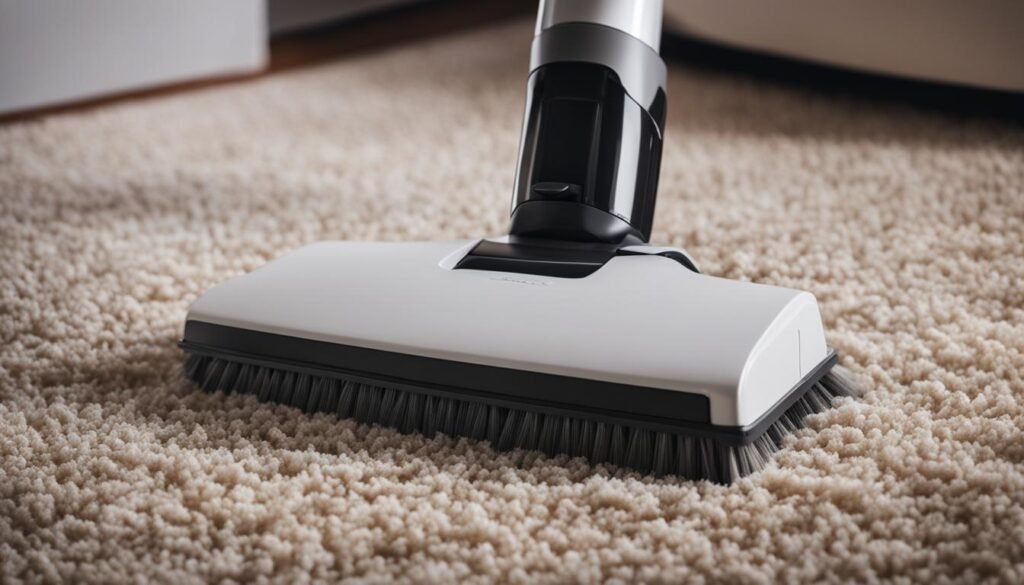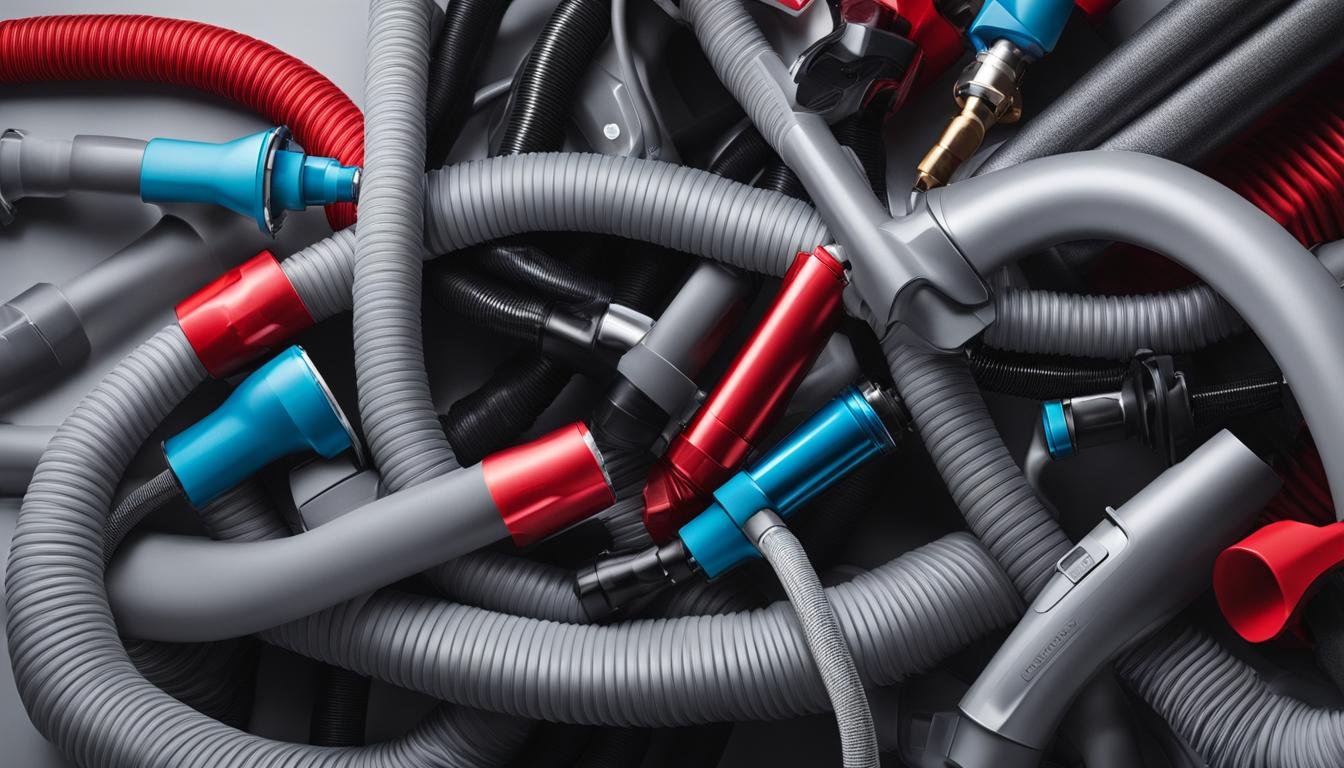Welcome to my complete guide on how to use vacuum cleaner attachments! Vacuuming is an essential part of keeping our homes clean and dust-free. However, with the right attachments, you can take your vacuuming routine to the next level and achieve a truly thorough clean. In this guide, I will walk you through the different types of vacuum cleaner attachments and provide you with tips and tricks on how to use them effectively. Whether you’re trying to reach high spots, clean upholstery, or tackle hard-to-reach areas, these attachments are designed to make your cleaning tasks easier and more efficient.
Key Takeaways:
- Understanding the different vacuum cleaner attachments can help you clean a variety of surfaces in your home.
- The crevice tool is perfect for cleaning tight spots and corners, while the dust brush is ideal for picking up dust and particles from surfaces like window blinds and shelves.
- Using the upholstery tool is a great way to keep your fabrics clean and fresh, such as mattresses and couches.
- Properly cleaning vents, walls, ceilings, blinds, and baseboards can contribute to a cleaner home environment.
- Regular maintenance and following the manufacturer’s instructions will ensure optimal use and longevity of your vacuum cleaner attachments.
Common Vacuum Cleaner Attachments and Their Uses
When it comes to keeping your home clean, vacuum cleaner attachments are invaluable tools that can enhance your cleaning routine. Understanding the different types of attachments and their specific uses will help you achieve the best results. Let’s explore some of the most common vacuum cleaner attachments and how to use them effectively.
1. Crevice Tool
The crevice tool is ideal for cleaning those hard-to-reach spots in your home. Its long, narrow shape allows you to easily access corners, crevices, and tight spaces. Whether it’s between sofa cushions, along baseboards, or behind appliances, the crevice tool can help you tackle dust and debris in those hidden areas.
2. Dust Brush
The dust brush attachment is designed to gently remove dust and particles from delicate surfaces. It features soft bristles that effectively pick up debris without scratching or damaging your belongings. Use the dust brush on window blinds, shelves, lampshades, or any surface that requires a gentle touch.
3. Upholstery Tool
If you have upholstered furniture or mattresses that need regular maintenance, the upholstery tool is a must-have attachment. Its wide, flat design with a fabric brush helps remove pet hair, dirt, and dust from fabric surfaces. Simply glide the upholstery tool over your furniture to keep it clean and fresh.
4. Turbobrush
The turbobrush attachment is perfect for carpets and rugs. Equipped with a rotating brush, it agitates the fibers to loosen embedded dirt and pet hair. The powerful suction of your vacuum cleaner then removes the loosened debris, leaving your carpets looking revitalized. Use the turbobrush regularly to maintain the cleanliness and longevity of your carpets.
These are just a few examples of the many vacuum cleaner attachments available. Remember, each attachment serves a specific purpose, so it’s important to choose the one that matches your cleaning needs. Experiment with different attachments and techniques to find the best way to utilize your vacuum cleaner attachments and achieve a sparkling clean home.
Comparison of Common Vacuum Cleaner Attachments and Their Uses
| Attachment | Uses |
|---|---|
| Crevice Tool | Cleaning tight spots, corners, and crevices |
| Dust Brush | Removing dust and particles from delicate surfaces |
| Upholstery Tool | Cleaning fabric surfaces (e.g., furniture, mattresses) |
| Turbobrush | Deep cleaning carpets and rugs |
Tips for Using Vacuum Cleaner Attachments on Specific Surfaces
Different surfaces require different techniques when using vacuum cleaner attachments. To ensure efficient and effective cleaning, here are some valuable tips:
1. Carpeted Surfaces:
Regular vacuuming using the appropriate attachment is usually sufficient for carpeted surfaces. Start by using a rotating brush attachment or a powered carpet brush to loosen dirt and debris. Follow a systematic pattern, moving slowly to allow the suction to pick up as much dirt as possible.
2. Hard Floors:
Hard floors may benefit from a combination of vacuuming and sweeping. Begin by using a floor brush attachment or a hard floor nozzle to remove loose dirt and crumbs. Then, switch to the vacuum’s suction mode to capture any remaining dust and small particles.
3. Stairs:
Cleaning stairs can be a challenging task, but with the right approach, it becomes much easier. Consider using a smaller, portable vacuum cleaner for better maneuverability. Alternatively, utilize the attachments on your existing vacuum, such as a crevice tool or a small brush, to effectively clean each step.
4. Walls, Ceilings, Blinds, and Upholstered Surfaces:
Each of these surfaces requires specific cleaning techniques. For walls and ceilings, consider using a soft brush attachment to gently remove dust and cobwebs. When cleaning blinds, opt for a dusting attachment or a soft cloth to avoid damaging the delicate slats. Upholstered surfaces, such as couches or mattresses, can benefit from a fabric brush attachment or a pet hair brush to remove dirt, dust, and pet hair effectively.
5. Vents and Baseboards:
Properly cleaning vents and baseboards can significantly contribute to a cleaner home environment. Use a long, slim attachment or a brush specifically designed for vents to remove built-up dust and debris. A crevice tool is a great choice for tackling the hard-to-reach areas along baseboards.
Remember, when using vacuum cleaner attachments on specific surfaces, it’s crucial to refer to your vacuum cleaner’s manual for any specific guidelines or recommendations provided by the manufacturer. With the right attachments and techniques, you can achieve exceptional cleaning results and maintain a spotless home environment.

Summary:
Using vacuum cleaner attachments on specific surfaces requires a tailored approach. Follow these tips to optimize your cleaning routine:
- Vacuum carpets with rotating brush attachments or powered carpet brushes.
- Sweep and vacuum hard floors using floor brush attachments or hard floor nozzles.
- Clean stairs using smaller, portable vacuums or attachments designed for stairs.
- Utilize soft brush attachments or dusting attachments for walls, ceilings, and blinds.
- Use fabric brush attachments or pet hair brushes for upholstered surfaces.
- Clean vents and baseboards with long, slim attachments or brushes.
By employing the right techniques and attachments, you can achieve exceptional cleaning results on a variety of surfaces in your home.
Conclusion
In conclusion, understanding how to use vacuum cleaner attachments is key to achieving a thorough and efficient cleaning routine. With the right attachments and proper usage, you can make the most of your vacuum cleaner and keep your home spotless. Remember to choose attachments that are suitable for the specific surfaces you need to clean, whether it’s carpets, hard floors, upholstery, or more.
Following the manufacturer’s instructions and guidelines is crucial for optimal attachment usage and performance. Regular maintenance, such as cleaning and replacing filters, will also ensure that your vacuum cleaner remains in top condition. By incorporating vacuum cleaner attachments into your cleaning routine, you can transform your vacuum into a versatile cleaning powerhouse that helps you maintain a clean and healthy living space.
So, the next time you’re faced with dirt, dust, and debris in your home, don’t forget to utilize the variety of vacuum cleaner attachments available to you. Vacuum cleaner attachments are not only practical but also essential tools for achieving a thorough clean on various surfaces. By employing the right attachments and following our guide, you can confidently tackle any cleaning challenge with ease.
FAQ
What types of attachments are common for vacuum cleaners?
Some common attachments for vacuum cleaners include the crevice tool, dust brush, upholstery tool, and turbobrush.
What is the crevice tool used for?
The crevice tool is perfect for cleaning tight spots and corners that are hard to reach with a regular vacuum head.
What surfaces can the dust brush clean?
The dust brush is ideal for picking up dust and particles from surfaces like window blinds and shelves.
How is the upholstery tool used?
The upholstery tool is designed for cleaning fabrics, such as mattresses and couches, by removing dirt and debris.
What are some tips for using vacuum cleaner attachments on specific surfaces?
For carpeted surfaces, regular vacuuming with the appropriate attachment is usually sufficient. Hard floors may benefit from a combination of vacuuming and sweeping. Stairs can be cleaned using a smaller, portable vacuum or by utilizing the attachments on your existing vacuum. Walls, ceilings, blinds, and upholstered surfaces each have their own specific cleaning requirements, and the right attachments can help you tackle these areas effectively.






Leave a Reply